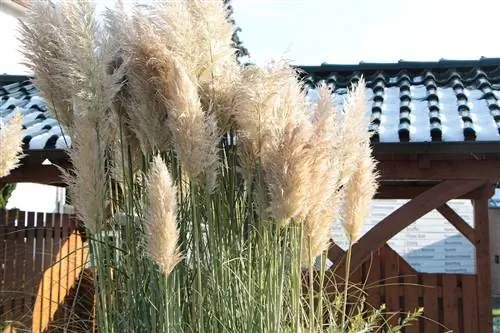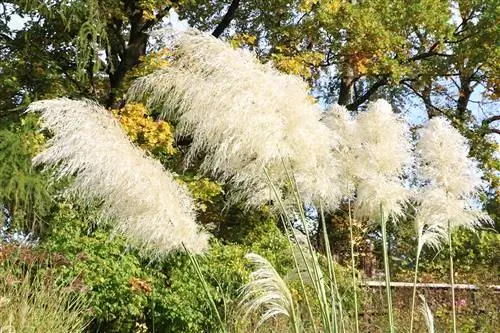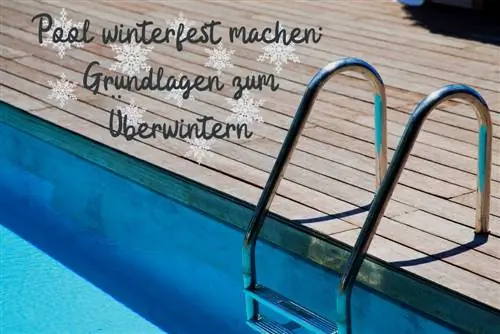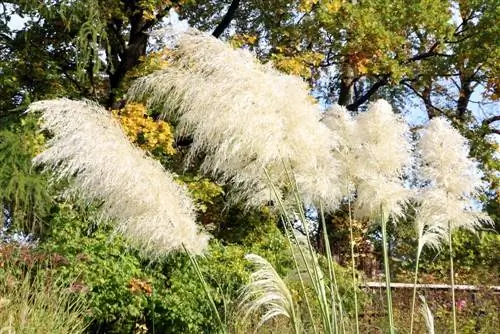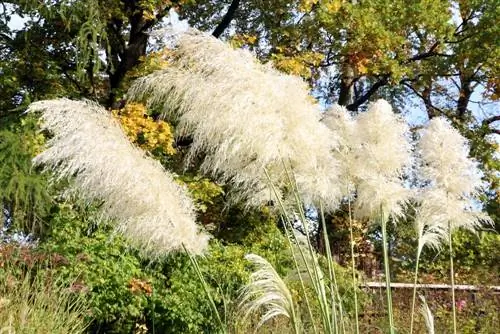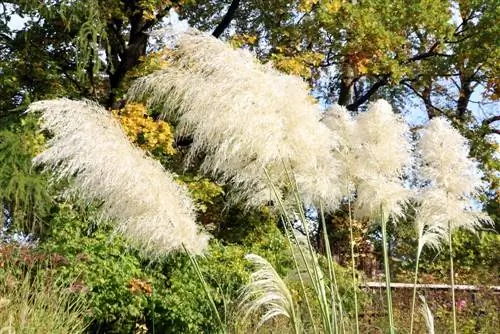- Author admin [email protected].
- Public 2023-12-17 03:39.
- Last modified 2025-01-24 12:45.
Overwintering pampas grasses is not difficult. This article will introduce you to various tips that will help you get the ornamental grasses through even the coldest winter days without any problems.
Wintering: note age
In order to overwinter pampas grass successfully, the age of the plant must be taken into account. This is one of the most important tips to survive the cold season without problems. The winter hardiness of pampas grass depends on the age of the specimen and young Cortaderia selloana are poorly winter-hardy. For this reason, you need good winter protection for them, as cold weather affects them in addition to moisture. Older specimens from two years of age are hardy without protection, but are just as sensitive to possible damage from moisture. Therefore, as a precaution, you should keep them protected through the winter, otherwise the following problem can arise due to too much moisture:
- excess moisture moves into the shoot base
- can't escape
- Roots and shoots begin to rot
- Plant dies over the winter
Note:
Winter protection is also important so that the stalks of the young pampas grasses do not freeze or the sun dries them out completely. This is often the case in unprotected places with intense midday sun and windy locations.
Don’t cut back
Avoiding autumn pruning is just as important as the age of the plant. This seems to be a good idea for the pampas grass, as many of the stalks die back by spring, but the ornamental grass depends on it. The stalks and fronds are the perfect basis for winter protection, regardless of whether you cultivate the plant outdoors or in pots. The green protects the roots from cold and moisture if it doesn't get too much. So you should safely avoid pruning in autumn and wait until spring.

Time
In order not to prepare the pampas grass too late for the cold season, you should not wait too long to take the necessary steps. For sweet grasses, the period between November and early December has proven to be ideal. The grasses do not have to and should not be packed up earlier, otherwise moisture is often still present between the stalks and can penetrate deep into the plant in mild to warm autumn temperatures. As a result, it begins to rot from the inside out. For this reason, choose a day during the specified period with the following characteristics to prepare the plant so that the stalks are completely dry:
- Temperature: up to -15°C
- younger specimens a little warmer
- dry weather
- if there is enough sunshine
Essential: Tie Up
Another tip to get the pampas grass safely through the winter is permanent winter protection. You have to tie the plant together well to protect the grass from a variety of possible problems:
- Moisture
- Sun
- Wind
You tie all visible parts of the silver pampas grass together. It is very important that you wear the right protective clothing because the stalks of the plant are sharp and can injure you. You need:
- Safety glasses
- long sleeve tops
- long pants
- Gloves
Since the stalks of the grass are very long, they can swing when tied. For this reason, you should not choose tops with short sleeves or shorts, as you will quickly incur cuts.
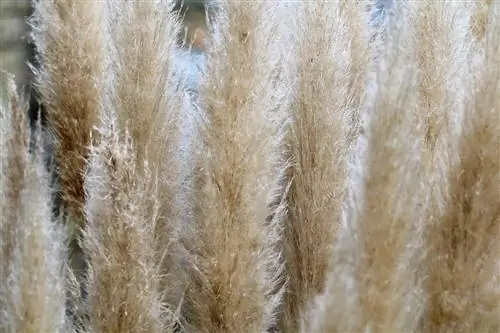
In addition to protective clothing, you will also need ropes made of coconut or hemp to tie the stalks together. The ropes are attached at a distance of around 40 centimeters. This way no moisture penetrates through the middle. To do this, proceed as follows, ideally in pairs:
- bring all the stalks together into one bunch
- hold tight at the top
- attach the first rope 40 cm above the ground
- Wrap rope around plant and tie it tight
- repeat 3 to 4 times depending on size
- don't tie the fronds together
- these have to stick out from the top
- check all ropes for fit
Wintering outdoors
If you overwinter your pampas grass outdoors, provide the root ball with an additional layer of brushwood, straw or dry leaves. This should be thick enough to prevent moisture from penetrating the soil. Since you don't have to water the ornamental grass in the garden over the winter, a thick protective layer is not a problem as the plant will not dry out. If you have planted a young specimen, you should wrap the tied stalks with garden fleece. This means it is better protected for the coming winter.
Preparing pot specimens for winter
Pampas grasses in pots also need to be provided with a protective layer over the root ball. This is done in the same way as explained in the previous section. Just make sure you have an easily accessible spot to check the substrate during dry spells in the winter. Since the pot does not have constant moisture available, you sometimes have to water on frost-free days. You also need to winterize the bucket. The plant is hardy, but if the pot cools down, it will die. To do this, proceed as follows:
- Place planters under eaves
- alternatively on a protected house wall
- Place the bucket on a base
- Suitable materials: Styrofoam, wood
- then pack up the pot
- Suitable materials: garden fleece, jute bag, bubble wrap, coconut mat
- Wrap young specimens with garden fleece
Tip:
Young pampas grasses can be overwintered in the basement, a frost-free garage or the winter garden. In this case, you can even cut the grass back in the fall to save space.
Winter without protection
If you live in a region where winter temperatures do not fall below -18°C, you can easily get Cortaderia selloana through the cold season without winter protection. Wine-growing regions, the Lower Rhine or communities west of the Black Forest, for example the Freiburg area, are particularly well suited for this purpose. This variant is extremely popular because the blades of grass look extremely decorative when there is enough snow.
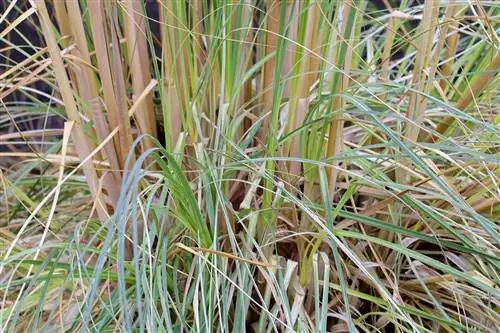
If you struggle with a lot of moisture over the winter, it can help to cover the unprotected grasses. But make sure that these are only adult specimens.
Tip:
As spring approaches, you may find broken stalks in your garden. Collect these too with protective gloves.
Pruning in spring
When it gets warmer again in spring, the perfect time to prune after wintering has come. It doesn't matter whether it's an outdoor specimen or a pot. Spring care is always carried out in the same way and completes wintering for the coming season. Follow these steps:
- put on protective clothing again
- remove dead or dried areas
- remove brown spots
- Comb the pampas grasses thoroughly
- use rakes for this
- then cut back according to eye size
- mulch at the end
- ideally with compost

